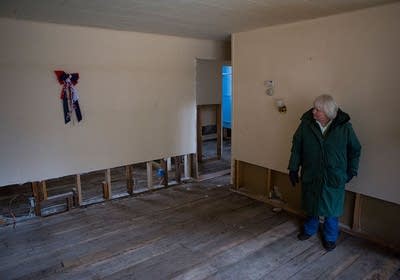Flood aid trickles in 6 months after NE Minnesota deluge

Six months ago this week, flash floods tore through northeast Minnesota, ripping up roads and filling basements. The disaster caused more than $40 million in damage to private homes -- many of them without flood insurance.
But some of the hardest-hit areas have so far received very little state or federal funding.
During the June flooding, sewer water gushed like a geyser from Jen Szczyrbak's bathroom in Moose Lake, Minn., and flooded her basement.
Her initial response was, "I can take care of this." Like a lot of people in a region that takes pride in self-reliance, she did not want to ask for help at first. But with $33,000 in damage and a deadline to make repairs because she's a foster parent, Szczyrbak knew she had to swallow her pride.
Create a More Connected Minnesota
MPR News is your trusted resource for the news you need. With your support, MPR News brings accessible, courageous journalism and authentic conversation to everyone - free of paywalls and barriers. Your gift makes a difference.
"Sometimes you get to that point where you have to just say, 'I need help, I can't do it,'" she said.
Szczyrbak applied for a loan from the federal Small Business Administration. That brought in about 40 percent of the repair costs. The family pieced together the rest from insurance, savings and fundraisers.
Now, Szczyrbak's basement is refinished, with fresh paint and new furniture and appliances.
"We are in a blessed position right now," she said.
• Click for more photos of flood recovery
This, ideally, is how disaster relief is supposed to work. People get back on their feet through a combination of state and federal no- or low-interest loans, private sources and volunteer efforts. And hundreds of homeowners like Szczyrbak have received the help they need.
But this scenario isn't playing out as often as disaster relief officials would like.
In Moose Lake, one of the hardest-hit towns, 127 homes sustained significant damage. As of Dec. 10, fewer than 20 percent of those homeowners have received state or federal financial assistance.

Officials expect those numbers to increase significantly over the next several months. But they acknowledge that they still haven't reached some people who need help, either because residents have not asked for it or think it's unaffordable.
Another resident, 65-year-old Linda Berg, walked carefully through the shell of her house in Moose Lake. The tiny bungalow is empty and cold, the appliances and furniture all long removed, the walls stripped to the studs.
Berg is now renting an apartment, but every day she returns to the house at lunchtime to pick up the mail and feed her two cats, who refuse to leave.
Berg has lived in this house for the past half century.
"At first there was so much work to do, I'd just come and work," she said. "Then, it was, you'd come and grieve a little. Now it's like coming to see an old friend."
A contracter told Berg the house needs $60,000 worth of repairs. The price tag persuaded her not to seek financial help.

"I thought at my age and at my health, I can't borrow $60,000," Berg said. "I just couldn't get that far in debt."
So the house just sits. Stories like Berg's are frustrating to officials like Tonja Orr, in part because state loans are forgivable after a decade.
"The concern is that we have money that the Legislature appropriated to help these folks, and we're not getting to them," said Orr, assistant commissioner for housing policy at the Minnesota Housing Finance Agency.
More than a dozen caseworkers from the Lutheran Social Service of Minnesota have been on the ground since Oct. 1. They have about 300 active cases and are still knocking on doors and making calls to find people who have slipped through the cracks. Orr believes there may be 100 to 200 people eligible for state loans who have not applied.
Cliff Knettel, deputy director of One Roof Community Housing in Duluth and co-chairman of St. Louis County's Long Term Recovery Committee for Duluth, said, "On a daily basis, we keep getting phone calls from folks who never heard about what assistance is available. We keep hearing from people who say, 'I've been waiting to be contacted.' Well, no one would know to contact them if their damage hasn't been reported."
As of a week ago, state and federal disaster relief loans have gone to only 234 households. That's just a fraction of the nearly 2,000 homes across the region significantly damaged by the flooding.
Two-thirds of the loans have gone to Duluth or elsewhere in St. Louis County, even though the county has fewer than half the damaged residences. In Carlton County the inverse is true. Carlton County has nearly half the damage in both dollars and number of homes, but residents there have received only about a third of the loans and total aid issued.

Officials attribute the situation to a reluctance to ask for help, and private grants that gave Duluth and St. Louis County a head start.
And many homes in the county still stand empty. Curt Yort, a Moose Lake city council member whose basement and family room flooded, points to five abandoned homes in his neighborhood.
"That brown house right over there is vacant; this gray house over here is vacant," Yort said. "I wonder what's going to happen to them."
Carlton County long-term recovery manager Drew Digby said small towns like Moose Lake face the possibilty of population loss.
"There's a fair number of homes that are on that borderline: Does it make financial sense to repair them?" Digby said. "And if they don't repair them, what is it going to do to the neighborhoods they were in?"
Officials say there's still plenty of financial assistance available. People just need to ask for it. The deadline to apply is Jan. 4.
